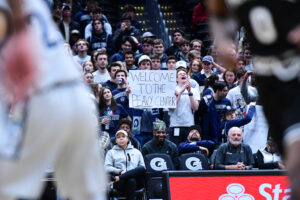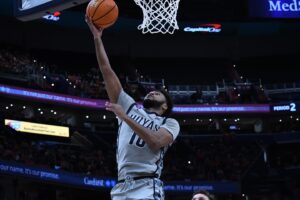Former Michigan State football coach Mark Dantonio, in one of my favorite quotes of all time, doubled down on the eternal and fierce rivalry between my beloved Spartans and their interstate competitors, the Michigan Wolverines.
Today, however, I frame his words of wisdom not in the context of a football game, but on the state of Georgetown’s men’s basketball program post-Ed Cooley hiring. It applies to recruiting, culture, and most notably, the state of the current roster:
“It’s not over, and it will never be over here. It’s just starting.”
Originally, this article was planned for late June, the official end of Ed Cooley’s first 100 days as head coach of the men’s basketball team. After former head coach Patrick Ewing’s exit, the hope was for a more normal offseason following the constant turmoil after the last two years. But then, what would have been considered shockingly late roster turnover in a normal year forced me to change my timeframe.
In June, the Hoyas failed to bring on former North Carolina transfer D’Marco Dunn, despite multiple predictions from industry experts that he would suit up in blue and gray.
Surely, I thought, Cooley will pivot quickly and land a different player to fill Dunn’s slot, and that’s when we’ll release this story. That’s what I told myself and my editor. Just a slight delay. Then, just as I was about to publish the piece, reports surfaced of Georgetown looking for another player to round out their rotation. Then, the news dropped in early August that Akok Akok would be leaving the Hoyas to play for West Virginia University.
You get the idea.
I’ve learned that when it comes to this year’s roster, like Coach Dantonio says, “It’s not over, and it will never be over here. It’s just starting.”
Of course, that is a little dramatic. As it stands today, this Georgetown roster features only nine of the NCAA-allocated thirteen possible scholarship players, with a tenth (Drew McKenna) hopefully enrolling soon. That’s certainly enough players to get by and survive a season’s worth of wear and tear, at least in theory. That number doesn’t include walk-ons, of which Georgetown has many, but good teams seldom have walk-ons in the rotation. Typically, Cooley has played with a primary rotation of eight to nine scholarship players, so this year’s team could have one or two to spare.
But this offseason has shown that things can shift at any moment. Do I know for certain if Georgetown is done making roster moves for this upcoming season? No. Does that matter anymore? Also no.
So, with that in mind, let’s finally get into it, shall we?
High School Recruiting
From a high school recruiting standpoint, Cooley has exceeded even the highest hopes. It was no surprise that Cooley got a couple of his best commits from his former school, Providence College, to come to the Hilltop, but the ability of him and his staff to both evaluate and land high-end high school talent has been a breath of fresh air for the program.
After years of failing to consistently recruit top-end talent at Providence, due in large part to the generally lackluster patch of talent in Rhode Island, Cooley’s move to a more recruiting-friendly school in Georgetown (given the multitude of talent that has come from the DMV in the past) has helped him to land five four-star prospects since landing on the Hilltop. First, there was former Providence signee and class of 2023 prospect, Drew Fielder, then former Friar commit and 2024 prospect, Kayvaun Mulready. Then, there was Thomas Sorber (class of 2024) from Philadelphia, Drew McKenna from Maryland—who will hopefully join the Hoyas at some point this upcoming season as a member of the class of 2023—and local prospect Caleb Williams (class of 2024).
And Cooley kept going, as if bringing in a three-man class of Sorber, Mulready, and Williams was not enough. Cooley continued his pursuit of players in the class of 2024, most notably bringing in five-star forward Derik Queen for an unofficial visit and building early inroads with priority prospects in the class of 2025 like DMV native guard Acaden Lewis.
Cooley and company have exceeded expectations in the high school recruiting sector. However, I would caution fans against looking at high school team rankings like 247Sports’s, which place the Hoyas in the top five as of publication, and thinking that we are now a recruiting powerhouse.
Cooley is notorious for prioritizing retention and experience—his philosophy is oft-referred to as “get old, stay old.” But given the tenuous dance between recruiting highly ranked players and hoping they stay in college long enough to pay dividends for the team, it’s not fair to expect a recruiting performance like Duke and Kentucky, who rely on being able to bring in and replace five-star talent on a yearly basis due to the one-and-done rule. That being said, there is nothing stopping Georgetown from joining UConn and Villanova atop the conference in landing quality talent year after year. For that to happen, though, it will take more than just one recruiting cycle, regardless of how well things have gone so far.
“It’s not over, and it will never be over here. It’s just starting.”
College Recruiting
While Cooley’s level of success on the high school trail has been a pleasant surprise, recruiting active college players through the portal was an area in which many expected Cooley to excel. Dating back to his time at Providence, Cooley has always been able to navigate his way through the transfer portal. Just a year ago, Cooley brought in major contributors like Bryce Hopkins, Devin Carter, and Corey Floyd, Jr., who helped give the 2022-23 Friars the juice they needed to make last year’s Big Dance. So far, the results at Georgetown have been a little murkier.
But it should be noted that unlike high school prospects, who may commit to a school like Georgetown for the coaching, development, and chance to raise a once-proud program from a period of unmitigated disaster, transfers are looking more for sometimes-gaudy NIL deals, immediate playing time, and winning rosters. As a result, it’s been hard to sell transfer prospects on a team that has gone 13-50 over the past two years. Any and all of these could be reasons that Cooley has shied away from some major transfer recruits. So while he has not gone to Build-A-Roster and built the best group of college basketball bag-chasers money can buy, Cooley has brought in a solid group that will work to re-establish the culture of Hoya basketball, helping the younger players develop and keeping the team competitive on the court.
Although the transfer class may technically be all new faces, Cooley and his staff have built years-long relationships with a couple of them dating back to high school. Take sophomore guard Jayden Epps, for example. He transferred in from Illinois, but Cooley and Providence were heavily involved in his initial high school recruitment, which gave them a leg up over other schools with coaches Epps may not have had an existing relationship with.
Beyond Epps, the group of players that Cooley was able to bring in from the portal have a variety of skill sets. Junior wing-forward Dontrez Styles from North Carolina brings massive potential via his impressive athletic ability. Sophomore guard Rowan Brumbaugh (Texas) has good court vision and positional size. Graduate forward Ismael Massoud (Kansas State) brings an incredible three point shooting ability, and senior Supreme Cook (Fairfield) is an excellent rebounder with an even more impressive effort level. Most notably, all but one (Massoud) have multiple years of eligibility remaining.
The overall roster may not look terrifying or even necessarily as talented as last season’s team, but a massive upgrade in the coaching department and a clear vision for how these pieces can fit and grow together is cause for real optimism as to what this group can accomplish.
Of course, that’s barring any more seismic shifts in the composition of the roster—something that may have sounded outlandish a few years ago given the old NCAA transfer policy, but is more possible in today’s day and age with the one-time free-transfer rule.
“It’s not over, and it will never be over here. It’s just starting.”
Culture
Probably the most important, albeit nebulous, thing that the Cooley regime must accomplish is an improved and revamped culture in and around Georgetown basketball. But in order to understand where Cooley and Co. are going, we first have to suck it up and acknowledge the situation the program was in when he took over.
Former head coach Patrick Ewing, despite running a program free of major scandals, was not built to be a head coach at the college level, and in this facet, Cooley should be a notable improvement. Despite Ewing’s clear eye for talent (see: his first two recruiting classes where he brought in current NBA players including Ömer Yurtseven, Mac McClung, Jamorko Pickett, James Akinjo, and others), Georgetown for the last few years has been an incredibly dysfunctional team, and a fair bit of that blame has to be put at Ewing’s feet.
The Mac McClung incident was one great example of this, though there have been several others. All one needs to do is look at the revolving door of players during the last few years to see that there was some mismanagement within the program. Now, to be fair, it seems unlikely that this mismanagement was all Ewing’s fault, but he certainly played a role, and that combination of factors has led the once-proud program to the low place it currently sits.
All of this is to say there that is still work to be done. Players wouldn’t have left in droves if that wasn’t the case. Capital One Arena wouldn’t struggle to fill a student section if it wasn’t the case. Rumors of dysfunction and lack of direction wouldn’t have popped up like weeds in my childhood garden if it wasn’t the case.
Since Cooley took over, we’ve seen him bring along nearly his entire on- and off-the-court staff from Providence, which is pretty impressive, considering some are Friar alumni. Cooley also started up in-program efforts like The Breakfast Club, a tradition of coaches having breakfast with players, another Providence import. He’s recruited promising high school talents, which could be incredibly impactful if he can keep up that momentum. The new staff brought in a good group of transfers, and with yearslong, preexisting relationships, the staff may have a solid idea for how personalities should mesh together as a team. It doesn’t take much more than a look around campus—or on the team’s social media—to see that times are changing here on the Hilltop. Whether it’s Cooley visiting new students moving into their dorms or selling basketball tickets outside of Harbin, there’s a new energy buzzing around campus. In a few short months, I have seen or heard of Cooley around campus more than I saw Ewing in my past two years here combined.
The full effects of Cooley’s strategy won’t be apparent for some time, but at least for now, it seems like this staff is pushing all the right buttons when it comes to projecting a revitalized vision of Georgetown basketball. One thing is clear already:
“It’s not over, and it will never be over here. It’s just starting.”






This is a great article!!